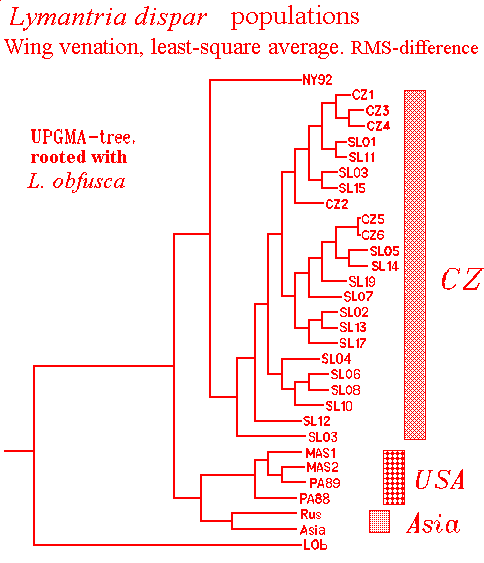
Tree based on average differences in venation between Lymantria dispar populations

Each population of gypsy moths represents the animals collected from a single site. All populations are represented by a sample of at least 25 individual males (with the exception of the NY population used to illustrate the effect of small sample size). The average positions of the 13 wing landmarks in each population were used to determine the wing shape difference between populations using the PLANAR program, downloadable from this site. The resultant difference matrix between all possible pairs was submitted to the UPGMA tree building algorithm in the PHYLIP package from Joe Felsenstein. North American populations cluster together irrespective of where or when they are collected. The Slovakian populations cluster together in one group. Neither repetition of collection sites in adjacent years nor proximity of collection sites effected the differences measured between pairs of wing averages in the Slovakian (and Austrian) populations. The Russian and Siberian populations also clustered together. The average resulting from the small sample from New York State (4 specimens) did not cluster with the Pennsylvania and Massachusetts population averages perhaps due to the inadequate sample size. Tentatively, we conclude there is an average shape about which local populations vary that is distinct enough for tree building which distinguishes European, Asian and North American populations of gypsy moth. Discrimination of individual membership in a continental origin is a distinct problem and will be addressed separately.
Analysis of a more extensive set of populations, including the above set, are in preparation for publication.
The cooperation and support of USDA APHIS in our developing the PLANAR software is acknowledged. Phil Kingsley of USDA APHIS shared the Pennsylvania (PA88 and PA89) and Asian (Asia) populations as well as the Lymantria obscura wings with me. Bill Wallner, of USDA Forest Service, Northeastern Forest Experiment Station, Hamden, Conn., provided our Yakovlevka, Russia (Rus) population. The extensive Slovakian populations came from Julius Novotny of the Forest Research Institute at Banska Stiavnica, Slovakia.